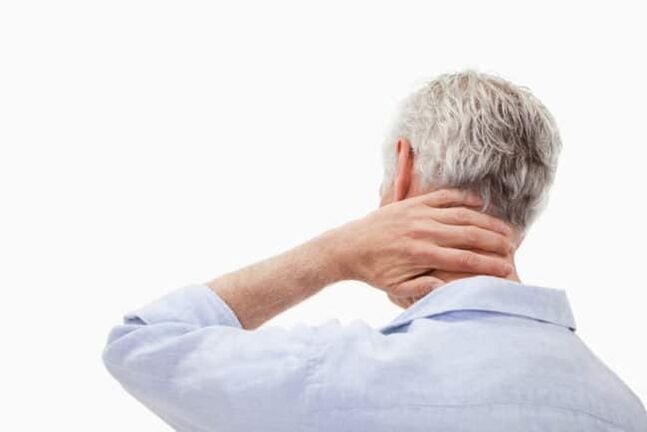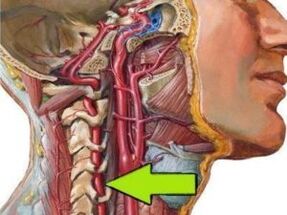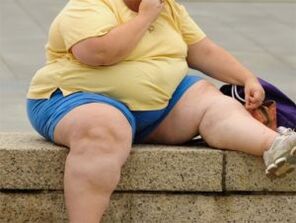Among all pathological processes that affect the spine in different parts, cervical osteochondrosis is considered the most common and painful.The disease leads to many complications, mainly as it affects the spinal cord, and also negatively affects brain function.

What is cervical osteochondrosis?
Words of cervical osteochondrosis in medical practice mean that progressive disease is obtained that affects certain spine.This pathological process is characterized by the degenerative-dystrophic process in the intervertebral disc tissue, which is a shock absorber for the cervical vertebra.Degenerative-dystrophic changes in the intervertebral disc is due to the fact that they are erased and defective.As a result, the distance between the vertebrae is reduced and the following consequences occur:
- Narrowing the spinal cord in certain areas of the spine.
- Passes the vertebral artery - a large blood vessel that provides blood supply to the brain.As the brain supply worsens and blood circulation in the cervical spinal cord is disrupted.
- The intervertebral disc can be defective and flattened.This leads to squeeze the individual parts of the spinal cord and nerves, more often, the nerve roots are squeezed.
All of these problems threaten not only violation of brain blood circulation, painful sensations in the neck, headache, and more.The development of osteochondrosis of the cervical area is dangerous to the problem of neurological properties, worsening the central nervous system, damage to the brain tissue.According to international disease classification, several separate codes are given osteochondrosis in the cervical region.Disease code for ICB 10 depends on the age of the disease: the disease is diagnosed:

- M02 - intervertebral disc dystrophy in adolescence.
- M42.12 is a dystrophic process in the neck in adults.
Many factors depend on the patient's age and the developmental stage of the pathological process, for example, the consequences, complications, symptoms and, of course, the principles of treatment.
Cause
Knowing the cause of the development of osteochondrosis of the cervical area can play an important role in the diagnosis process, as well as determine the principles of combating the disease.However, before listing the reasons, it should be said that doctors distinguish two factors that lead to the development of this pathological process:
- Pathology - the destruction of intervertebral discs and other vertebrates with the involvement of nearby tissues, blood vessels and nerve beams in the pathological process under the influence of poor external factors.The more difficult these factors and other pathologies, the faster the disease develops.
- Physiology - based on pathological development, especially age -related changes.We talk about the natural aging of cartilagin tissue in the spinal column, salt, etc.
If we list the main causes of cervical osteochondrosis, they are as follows:
- Violation of metabolic processes in the body, as well as certain levels of obesity.
- Hypodynamia is a phenomenon characterized by mobility limitations.It is not only about injury or disease, it also includes an inactive lifestyle and sitting work.
- The pathology of the cardiovascular system, which contributes to impaired blood circulation in the brain, changes in stress and other things.
- Incorrect posture, these are various forms of scoliosis, rheumatism and even flat feet.
- Cervical spine injection.In this case, we talk about sprains, strikes, bruises.Other spinal investigations in the development of cervical osteochondrosis can affect the development of cervical osteochondrosis.
- Excessive physical meaning in the cervical region caused by difficult or physical sports, depending on the type of human activity.
- Inactive lifestyle is also dangerous with persistent tension from the cervical spine and the whole spine, if you sit wrong or uncomfortable furniture.
- Cervical spinal hernia, as well as a variety of related diseases.
- Forcing the length of holding the head in an uncomfortable or improper position.In this case, not only the overstrain muscles occur, but the spine is also curved in the cervical region.
- The doctor considers the constant pressure and the very common nerve overvoltage.
- One of the reasons is also considered congenital anomalies in the spinal structure.

What is the health hazard?
As mentioned earlier, in the cervical spine, not only the spinal cord and various branches of the nerves are located, but also the spinal artery that supplies the brain's occipital parts, cerebellum and medulvic brain.With the development of cervical osteochondrosis, nearby tissue is inflamed.In addition, the development of pathology threatens to squeeze the nerve roots and transmit blood vessels, as the following are as follows:
- Osteochondrosis is accompanied by spinal deformation, as a result of the cerebrospinal canal narrowed in certain areas.This can lead to spinal cord and nerve branches, which promise severe neurological problems.In severe cases, one feels pain, though there is a possibility of loss of control over the individual part of the body (especially in the hands or face).
- Packing the vessels -the necklace, as mentioned, is accompanied by a violation of blood circulation in the brain's occipital region.At the same time, the brain stops receiving oxygen and nutrients in the required amount, the starvation of oxygen begins.With blood circulation disorders, there is a real risk of ischemic stroke and various neurological pathologies.
Syndrome
The main syndrome is:
- Vertebral.
- Vertebral artery.
- Korshka.
- Heart.
It is important to know that each of these symptoms is accompanied by a painful sensation of different properties, as well as many bad clinical signs.One can feel dizzy, noise appears in his ear and more.

Vertebral syndrome
It talks about the direct connection of the cervical area osteochondrosis with bone tissue and cartilagin.Symptoms in this type of pathology are also associated with tissue wounds mentioned:
- Neck movement is part or completely limited.
- The head movement is accompanied by pain in the neck.
- X -ray shows morphological changes in tissues (intervertebral and in the body of the vertebra).
Keep in mind that vertebral syndrome is always accompanied by these three clinical signs.If at least 1 of them is absent, the diagnosis will be completely different.
Rook Syndrome
It occurs when the spinal cord root is damaged.At the same time, nervous conductivity is disrupted, one can experience pain or loss of sensitivity to individual parts or even paralysis.Depending on which of the 8 radicular couples there are conductivity disorders, the symptoms are distinguished:
- 1 pair - numbness or pain in the back of the head;
- 3 pairs - breach of chewing reflex, numbness from the tongue and unpleasant sensations behind the ear;
- 4 couples - pain in clavicle, violation of swallowing reflex;
- 5 pairs - shoulder tie violations, accompanied by hand movement problems;
- 6 couples - patients begin to feel pain and numbness in the arm and shoulder blade;
- 7 couples - hands and fingers go to numbness (often index and middle);
- 8 pairs - a problem similar to past items, but numbness is felt on the ring and a small finger.
Cardial Syndrome
Although the pathological process is still located in the cervical spine, this syndrome has all the signs of heart pathology.The clinical picture is as follows:
- Pulse Rapid.
- Pain in the sternum region.
- Shortness of breath, weakness, fatigue, decrease in performance.
Signs and symptoms of cervical osteochondrosis
To find the right doctor, it is necessary to understand the signs of cervical osteochondrosis.In some cases, such knowledge allows you to seek help in the early stages of the disease, when it is easier to treat.In general, symptoms for cervical spinal osteochondrosis are as follows:

- The pain for osteochondrosis is always present, only the intensity and frequency are different.It is a pain that is the first clinical sign.Their intensity depends on the level of development of the disease, naturally they are stupid or red.Painful sensations are present especially in the neck of the occipital region, but can also emit to the temporal region, shoulder and hand.
- In most cases, there is a manifestation of vestibular wounds.We talk about dizziness that are not caused by dizziness, nausea, movement coordination, uneven gait, loss of space.
- One of the most common clinical signs is the rigidity of the neck muscles and the stiffness of movement.It is difficult for a person to turn, to lower his head, to respond to pain.
- Many patients note that the goosebumps "run through the scalp" or a tingling feature.
- In the arm area there is muscle weakness and numbness.
- There are usually psychological manifestations, which are expressed in depression, drowsiness, sharp changes in mood, anger or irritability.
- Due to the affected blood circulation and damage to the brain tissue, dizziness is increasing and the sound in the ear appears, just like sweating, pulse, ringing.
- Most patients note visual deterioration, as well as pain in the eyeball, especially when trying to cut the eyes left, right, up or down.
Sometimes it is possible to determine the developmental stage of the pathological process by symptoms.However, for this complete diagnosis, this is still insufficient and some diagnostic measures are required.
Diagnostic method
Diagnosis of cervical spinal osteochondrosis is necessary to determine the localization and stage of disease progression.For full diagnosis, such a diagnostic method is required:
- X -ray - the main method that allows you to determine the level and localization of the spinal column deformation.
- You can use computed tomography for more accurate diagnosis of pathological changes in vertebral and intervertebral discs.
- MRI (Magnetoresonance imaging) - allows to examine the wheels and vertebra in detail, determining the presence of hernia, protrusions, and the remaining lesions.
- Doplerography - at the same time, examinations are an opportunity to find a place to squeeze the arteries, assessing the level of blood circulation disorders.
Method of treatment
Treatment of neck osteochondrosis always implies an integrated approach.The principles of treatment depend on the mass of factors, such as the age of the patient, the level of disease progression, the brightness of the clinical picture, and others.However, you cannot do without a doctor in this situation and first you can consult a therapist who will then direct you to a vertebrologist.For integrated approaches: cervical osteochondrosis osteochondrosis is treated using drug therapy, physiotherapy, massage, exercise therapy and other methods that need to be discussed in more detail.
Drug
The basis for the treatment of cervical osteochondrosis is drug therapy, which involves the use of tablets, drugs and drugs:
- Anesthetics - analgesic and antispasmodic.The former nerve center is directly boring, thus stopping the painful sensation.The latter allows you to relieve neck muscle cramps, establish blood flow and suppress pain.
- NSAIDs -Anti -Non -ssteroidal medicine is needed to reduce the inflammation process, most of which also eliminate pain.Often these medicines are used in the form of gels, ointments that are applied to the affected area.
- Musorelaxants are another way to eliminate muscle cramps in the cervix region.
- Chondroprotectors are mandatory at certain stages of osteochondrosis chop, as they contribute to the recovery of bone tissue.
- Vitamin B - normalizes the metabolic processes of the nerve tissue, increases the conductivity of nerve impulses and contributes to the functioning of the central nervous system.
Remember, treatment should be performed only under the supervision of a doctor, who is responsible for the appointment of each drug, as well as determining the duration of intake and dosage.
Physiotherapy
Treatment of neck osteochondrosis will be more effective in using some physiotherapy techniques:

- Electrophoresis.
- Laser therapy.
- Ultrasound.
- Massage.
Massage therapy should be carried out by experienced health workers, treatment is performed by at least 10 sessions.Cervical region sequences help normalize blood circulation, restore elasticity, muscle tone, relieve pain, etc.
Manual therapy
Manual therapy is based on the principle of restoring motor function and mobility between vertebrae.Initially, the manipulation was in a light relaxing massage, so the doctor attached more strength, acting on pressure vertebra and neck turn.
The use of Kuznetsov applicator is one of the therapeutic methods for spinal diseases, including osteochondrosis.The effects of adjusting in the cervical region normalize metabolic processes, relieve pain, improve muscle tone, improve blood circulation, improve nerve tissue conductivity, etc. to prevent osteochondrosis, useful to engage in swimming and hang in horizontal bars for 2-3 minutes daily.



























































































